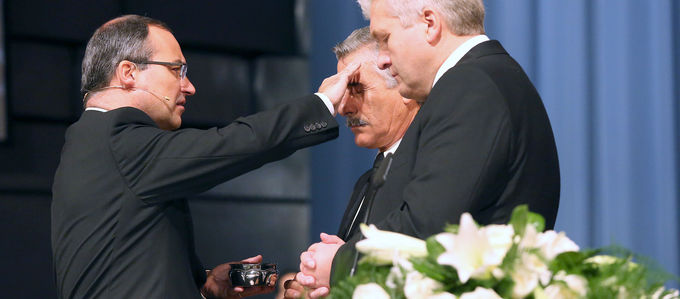
Whether it is considered a rite, a sacrament, or merely a side effect of baptism, the churches have very different ways of understanding how a Christian receives the Holy Spirit. And this diversity of perspectives has a tradition that goes back nearly 2,000 years.
The manifesto might well have looked like this: God granted Christendom a new outpouring of the Holy Spirit, thereby reviving the early church and its gifts of the Spirit, such as healing of the sick and speaking in tongues. This is something the believer now can, and indeed must, experience personally—and then everything fits into place again with respect to the preaching and spread of the gospel.
The Spirit starts the process
No, the aforementioned manifesto is not a reference to the 1830s, when the Apostle ministry was newly occupied. Nor does this formulation apply to the emergence of the Pentecostal Churches in the 1900s. Rather, these words reflect the commonalities of the charismatic impulses that captured the imagination of all the major churches except the Orthodox Churches in the 1960s. And similar ideas can also be traced back at least to the renewal movement of the Montanists in the 160s—in other words, to the earliest period of the church.
How can the Holy Spirit be received? What are the effects of this act? And how are these effects exhibited? Questions such as these have moved Christendom since its beginnings. Why should these questions be so important? Clearly, Jesus Christ is the Redeemer, but at the beginning of the redemption process, the gift of the Spirit must be conferred upon the believer. The biblical Apostle Paul makes this clear again and again.
The Churches respond
The answers as to when, how, and where turn out to be completely different in the various Churches: “Christians differ in their understanding as to where the sign of the gift of the Spirit is to be found,” notes the celebrated Lima Declaration of 1982, a key document of ecumenical rapprochement.
“Different actions have become associated with the giving of the Spirit,” it goes on to say in Point 14: “For some it is the water rite itself. For others, it is the anointing with chrism and/or the imposition of hands, which many churches call confirmation. For still others it is all three, as they see the Spirit operative throughout the rite.”
The Bible leaves a great deal open to interpretation
“The argument over the timing, meaning, and proof of manifestation of the outpouring and reception of the Spirit at the beginning of Christian life have their roots in the complex testimony of the New Testament.” Such is the verdict of an approximately 9,000-page lexicon entitled Religion in Geschichte und Gegenwart (Religion in history and the present). In other words, the Bible itself is to blame for all the confusion.
After all, the accounts pertaining to the manner in which the believers received the gift of the Spirit—as recorded in the Acts of the Apostles in particular—are not clear. And so it is that Christians of different times and different denominations have always found different points of biblical reference for their understanding, whether it is called “confirmation” in Catholic circles, “Chrismation” in the Orthodox Churches, or “Holy Sealing” in New Apostolic terminology.
There is one thing on which all the churches can agree, however: it was Jesus Christ who suddenly made that power which unites human beings with God accessible to them. He was the first who was said to have baptised with the Spirit. And so began a 2000-year journey of adventure.
Photo: BillionPhotos.com – stock.adobe.com














